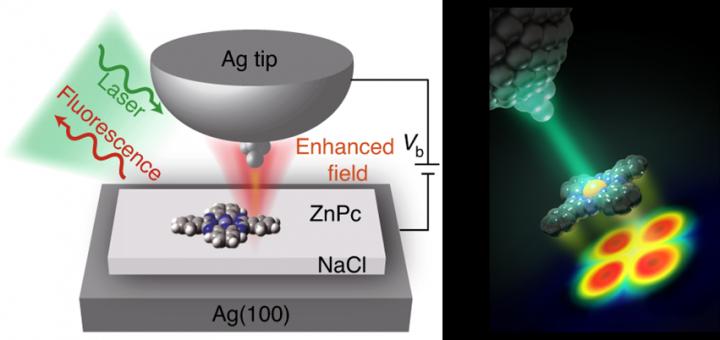Optical imaging enters sub-nanometer era

Schematic of the experimental set-up for single-molecule photoluminescence imaging with sub-nanometer resolution
Credit: YANG Ben, HUANG Wen et al.
Prof. DONG Zhenchao and Prof. HOU Jianguo from University of Science and Technology of China (USTC) of Chinese Academy of Sciences (CAS) improved the spatial resolution from 8 nm to ~8 Å of photoluminescence imaging. It realized sub-molecular resolution with single molecule photofluorescence imaging for the first time.
This study was published in Nature Photonics on August 10.
To reach atomic resolution with light has always been one of the ultimate goals in nano-optics. The advent of scanning near-field optical microscopy (SNOM) kindled hopes for the goal.
Prof. DONG and his colleagues successfully demonstrated sub-nanometer scale spatial resolution in the single-molecule Raman spectroscopy imaging with local enhancement effect of a nanocavity plasmon field in a study in 2013.
However, unlike the Raman scattering process, fluorescence will be quenched in the very immediate vicinity of metals which stops the resolution development of SNOM at around 10 nm.
The radiation properties (fluorescence) of molecules in the metal nanocavity are directly affected by the photon density of the nanocavity , and the photon density of the nanocavity is closely related to the structure of the probe tip. Therefore, it is the key to modify the structure of the probe and the electronic state of the molecules in the nanocavity to avoid the fluorescence quenching and achieve high-resolution photofluorescence imaging.
DONG’s team further fine-tuned the plasmon nanocavity, especially in the fabrication and control of the atomic-level structure of the probe tip. They constructed an Ag tip apex with an atomistic protrusion and matched the nanocavity plasmon resonance with the effective energy of the incident laser and molecular luminescence.
Then, the researchers used an ultra-thin dielectric layer (three-atom-thick NaCl) to isolate the charge transfer between the nanocavity molecules and the metal substrate, achieving sub-nanometer resolution of the single-molecule photoluminescence imaging.
They found that with the probe approaching the molecule, even if their distance is less than 1 nm, the intensity of photoluminescence continues increasing monotonously. And the fluorescence quenching disappears completely.
Theoretical simulations showed that when the atomistic protrusion tip and the metal substrate form a plasmon nanocavity, the resonance response of the nanocavity plasmon and the lightning rod effect of the atomistic protrusion structure would have a synergistic effect. The synergistic effect generates a strong and highly localized electromagnetic field compressing the cavity mode volume to below 1 nm3, which greatly increases the localized photon density of states and the molecular radiation decay rate. These effects not only inhibit the fluorescence quenching, but also realize sub-nanometer-resolution photoluminescence imaging.
To achieve sub-nanometer spatial resolution, the size of the tip and the distance between the tip and the sample must be on the sub-nanometer scale.
The researchers further realized sub-molecular-resolved photoluminescence hyperspectral imaging with spectral information, and demonstrated the effects of local plasmon-exciton interaction on fluorescence intensity, peak position and peak width on the sub-nanometer scale.
This research achieved the long-awaited goal of using light to analyze the internal structure of molecules in SNOM, and provided a new technical method for detecting and modulating the localized environment of molecules and light-matter interactions on the sub-nanometer scale.
The reviewers of Nature Photonics say that this paper will be an important article in its field, which has guiding significance for carrying out ultra-sensitive spectroscopic microscopy research with atomic-scale light.
Media Contact
All latest news from the category: Physics and Astronomy
This area deals with the fundamental laws and building blocks of nature and how they interact, the properties and the behavior of matter, and research into space and time and their structures.
innovations-report provides in-depth reports and articles on subjects such as astrophysics, laser technologies, nuclear, quantum, particle and solid-state physics, nanotechnologies, planetary research and findings (Mars, Venus) and developments related to the Hubble Telescope.
Newest articles

Economies take off with new airports
A global study by an SUTD researcher in collaboration with scientists from Japan explores the economic benefits of airport investment in emerging economies using nighttime satellite imagery. Be it for…

CAR T–cell immunotherapy targets
Pan-cancer analysis uncovers a new class of promising CAR T–cell immunotherapy targets. Scientists at St. Jude Children’s Research Hospital found 156 potential CAR targets across the brain and solid tumors,…

Stony coral tissue loss disease
… is shifting the ecological balance of Caribbean reefs. The outbreak of a deadly disease called stony coral tissue loss disease is destroying susceptible species of coral in the Caribbean…





















